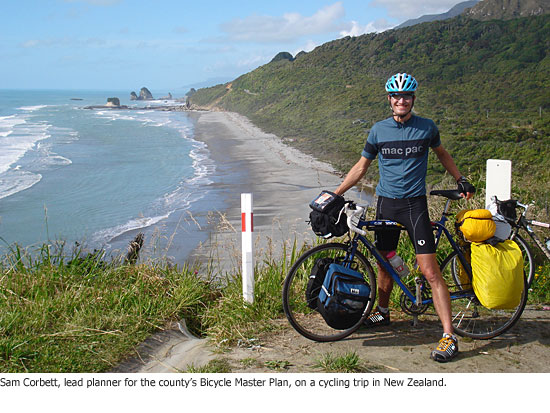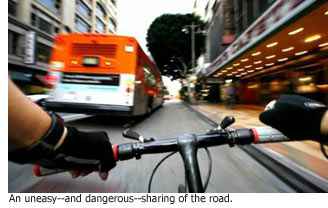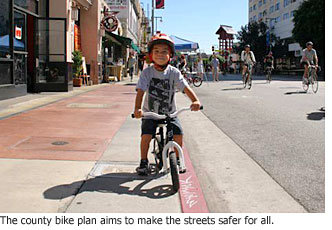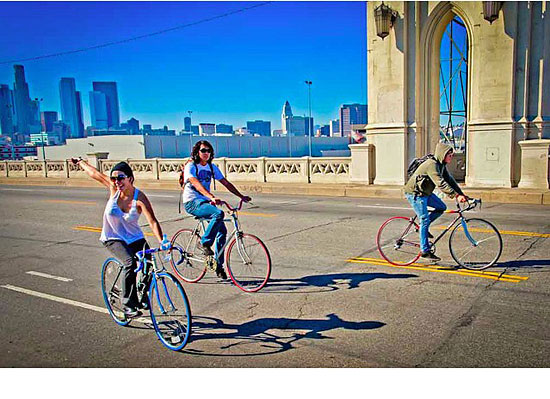County gets rolling on a new bike plan
March 10, 2011
 The last time Los Angeles County created a bicycle plan, disco was king, “Jaws” was chewing up the box office and Chevy Chase was channeling Gerald Ford on “Saturday Night Live.”
The last time Los Angeles County created a bicycle plan, disco was king, “Jaws” was chewing up the box office and Chevy Chase was channeling Gerald Ford on “Saturday Night Live.”
Times change, and so has Los Angeles bike culture. Now the county’s jumping into the cycling revolution with both wheels.
A newly drafted Bicycle Master Plan, the county’s first since 1975, puts forth a wide-ranging new blueprint for cycling in Los Angeles County that includes the creation of 695 miles of new bikeways in unincorporated territory over the next two decades, including 20 miles of rider-friendly “bike boulevards.” Nearly 300 miles of the new bikeways would be dedicated bicycle paths and lanes, while the rest would fall under the category of “bicycle route,” in which signage and, potentially, pavement markings, would designate preferred cyclist thoroughfares.
The plan as drafted also contains a range of policy and program recommendations, including support for new “end-of-trip” facilities for cyclists to stow bikes and maybe take a shower; a push for a county “healthy design ordinance”; proposals to make roads safer for cyclists; a recommendation to add bicycles to the county’s transportation fleet; and an endorsement of bicycling as a valid, and growing, transportation option that makes people and communities healthier and more environmentally-friendly.
“It’s a sweeping document in that it provides a vision,” said Abu Yusuf, the county’s bikeway coordinator. “We’re trying to be very proactive.” He said the draft plan is as much about human behavior as it is about infrastructure: “If people aren’t motivated to use the bikeways and to feel safe doing so, they’re not going to use the facilities.”
The plan goes out for a final round of public comments later this month. Once those comments are integrated into the document, the plan, if adopted by the Planning Commission and Board of Supervisors, would become part of the county’s General Plan.
The action on the county bike plan comes as Los Angeles rides a huge wave of cycling activism. The city, to great acclaim, recently approved a new bicycle plan that aims to add 1,680 miles of new bikeways. Bicycle advocates have also pushed for greater law enforcement attention to motorists who hit cyclists, for “sharrows” markings to make it clearer that cars need to share the streets with their two-wheeled brethren, and for bike-friendly amenities like a new “bike corral” in Highland Park and “open street” events like CicLAvia.
“The cyclists have come out of the woodwork, so to speak, in the last 18 months and demanded that government do better. And the county is doing better,” said George Wolfberg, a member of the county’s bicycle advisory committee, which helped prepare the draft plan.
Sam Corbett, a senior associate with Alta Planning + Design, which created the bicycle plan draft for the county’s Department of Public Works, said street-level efforts in Los Angeles are part of a larger national picture.
“I’ve found that grassroots activism plays a critical role in pushing the agenda and elevating the importance of bicycling issues in Los Angeles and in other cities throughout the country,” Corbett said. “Without advocates and concerned citizens’ requests for more bicycle-friendly policies, programs and facilities, there’s no question that we wouldn’t have seen as much progress in the past 10-15 years throughout the country in improving bicycling conditions.”
 The county plan proposes adding four kinds of bikeways at a cost of $284.8 million over the next 20 years. Those include some 69 miles of “Class 1” car-free bike paths that would be created in unincorporated pockets across the county, with the largest stretches in the San Gabriel and Santa Clarita valleys. There also would be nearly 225 miles of “Class 2” bicycle lanes, with dedicated space for cycling painted onto roadways throughout unincorporated Los Angeles County.
The county plan proposes adding four kinds of bikeways at a cost of $284.8 million over the next 20 years. Those include some 69 miles of “Class 1” car-free bike paths that would be created in unincorporated pockets across the county, with the largest stretches in the San Gabriel and Santa Clarita valleys. There also would be nearly 225 miles of “Class 2” bicycle lanes, with dedicated space for cycling painted onto roadways throughout unincorporated Los Angeles County.
And the plan calls for creation of more than 380 miles of “Class 3” bicycle routes—primarily in the Antelope and Santa Clarita valleys, but also through the Santa Monica Mountains.
“Don’t get too excited about that, unfortunately,” said Tom Foote, a lawyer who regularly commutes from his Topanga home to his office in Santa Monica. Foote, a member of the bicycle advisory committee that consulted on the report, said no one should expect to wake up one day to find a dedicated bike lane running through the mountains; the topography would make it tough, if not impossible, to widen roads sufficiently.
However, the bicycle route designation would mean bicycle signage and possibly shared lane markings in some areas, and would require future planners to consider bicycle needs when they work on roads in the future.
Finally, the report advocates creating 20 miles of “bicycle boulevards” in the San Gabriel Valley and the county’s central, urban core. Such boulevards—with “calming” features such as traffic circles, along with signage and shared lane markings, added to streets that already have low automobile volumes—have proven popular with families and other riders in places like Berkeley, Corbett said.
The plan covers all of unincorporated Los Angeles county, with nearly 2,657 square miles comprising 65% of the county’s total land but home to just 11% of its population. The sheer size poses difficulties for bicycle planners.
“The challenge in a lot of the county is that it’s vast. There’s a huge amount of space,” Corbett said, noting that while trips of 5 miles or less can be enticing to a would-be cyclist, 15- to 20-mile voyages in places like the Antelope Valley can be daunting.
Another obstacle comes from Los Angeles’ entrenched car culture. “Politically and just practically, it can be challenging to put in bikeway facilities,” Corbett said.
To help overcome those challenges, the plan marshals an array of environmental, health and safety information to make the case for thoroughly integrating bicycles onto Los Angeles streets that have long been considered—by some—to be the exclusive domain of automobiles.
Among its findings:
Streets must be made safer for cyclists. There were 1,307 collisions involving bicycles reported in unincorporated county areas from 2004-2009. Many of those—228—took place in East Los Angeles. On the Westside, there were 56 crashes, with the vast majority (37) occurring in Marina del Rey. “Bar none, safety is the No. 1 concern that citizens have with cycling,” Corbett said. Helping people overcome those fears through education and better design puts more cyclists safely on the streets, the report said.
Bicycling is the green transportation choice. By 2035, increased bicycle use is expected to reduce the number of vehicle trips in unincorporated areas by more than 6 million a year, reducing emissions of hydrocarbons, carbon dioxide and other substances linked to climate change and smog.
Cycling is a public health issue. Bicycle-friendly communities contribute to improved public health by encouraging physical activity and helping to combat chronic diseases such as diabetes and heart disease.
Riding is a lot cheaper than driving. The report said cyclists’ annual operating costs run just 1.5% to 3.5% of motorists’ expenses. (An argument that seems likely to get more persuasive as gas prices move north of $4 a gallon.)
In undertaking its first bike master plan in 36 years, the county has to make up for lost time, and lost funding opportunities. The biggest state source of funding for commuter bike facilities requires master plan updates every five years, Corbett said.
The bike master plan puts the county back in the game—lagging behind places like Portland, New York and even Long Beach, but ready to roll. “It’s undoubtedly a big advance over the last master plan, which is ancient and completely outdated,” Foote said.
“This is a major document,” added Yusuf. “It provides a vision for what the county wants to do.”
 Public workshops on the county’s Bicycle Master Plan begin March 28 at 6 p.m. at the Topanga Elementary School. For a list of meeting times and locations, click here.
Public workshops on the county’s Bicycle Master Plan begin March 28 at 6 p.m. at the Topanga Elementary School. For a list of meeting times and locations, click here.
Posted 3/10/11












 405 bridge work causes a stink
405 bridge work causes a stink
